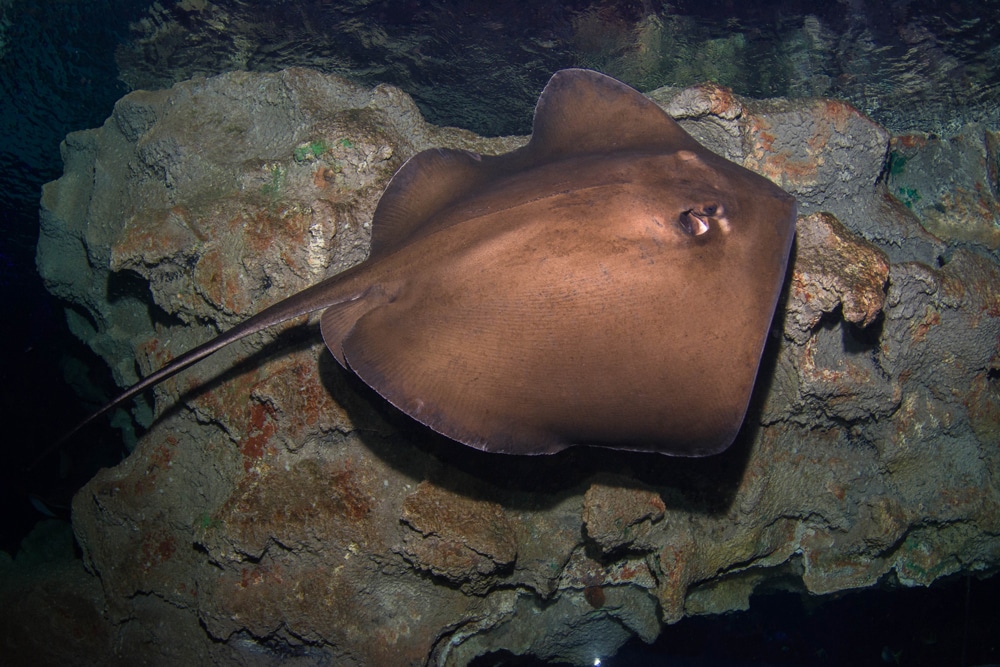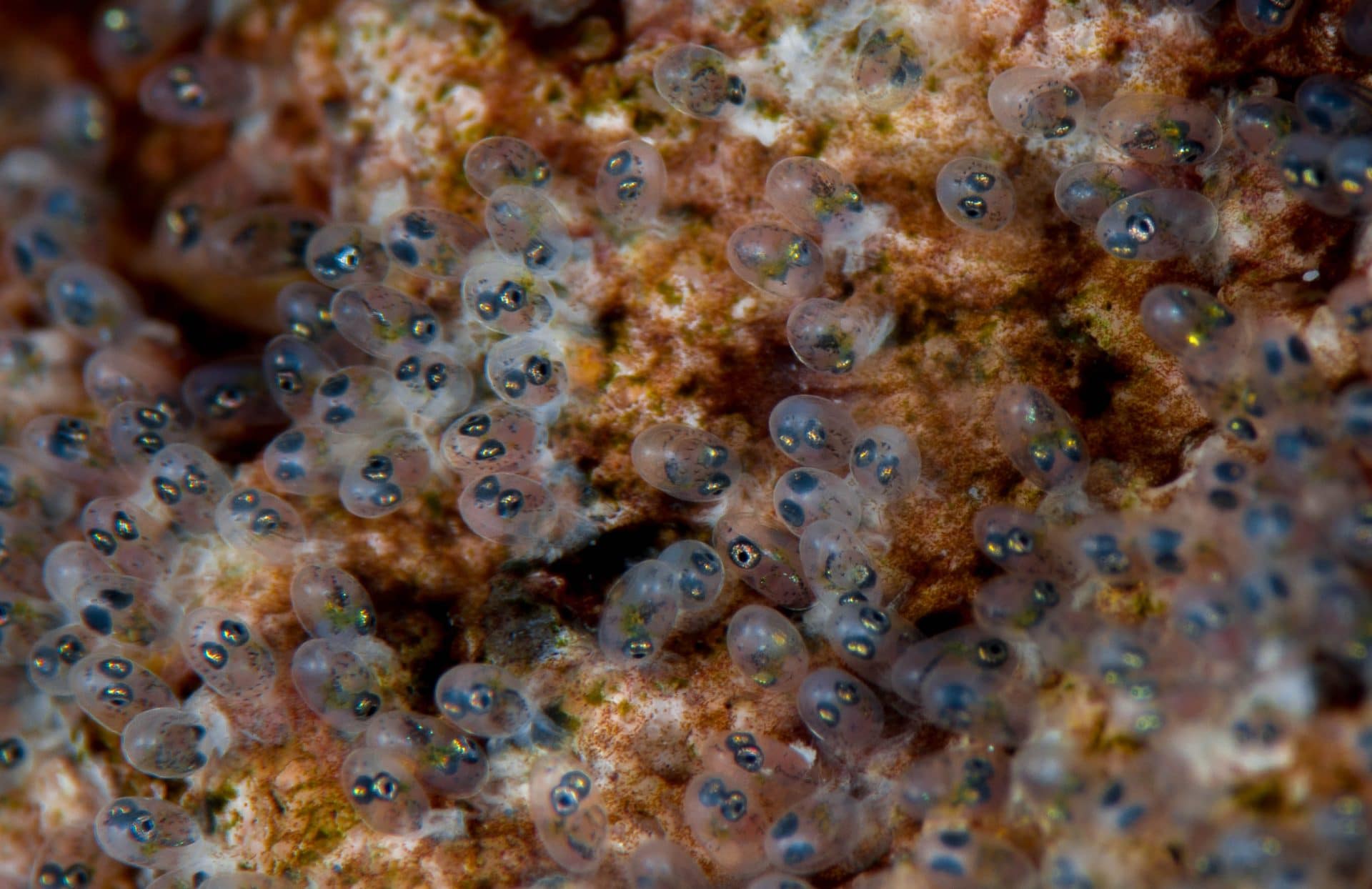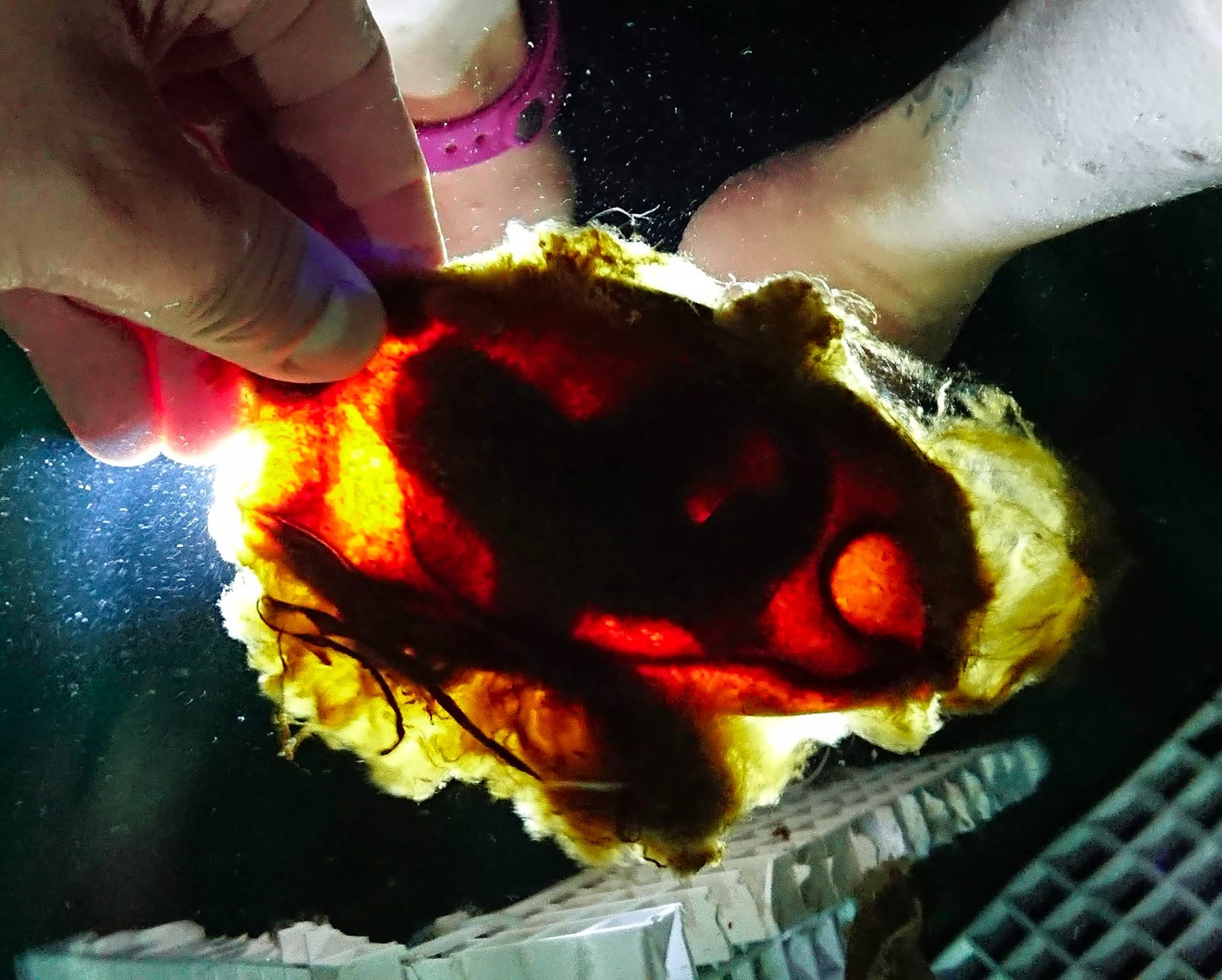Marine Life & Conservation Blogs
Breeding at Blue Planet

Breeding in the main tank at Blue Planet
Here at Blue Planet Aquarium we have many animals that live in our main tank, everything from our Sand Tigers all the way down to our Goliath Grouper. But there are a few animals in our main tank that breed on a more than Regular basis. In this article we are going to talk about three of them.
The first one is instantly recognisable as it is one of our signature animals, the Southern Atlantic Stingray. This species can grow up to nearly 5 feet across, with males being significantly smaller at around 2 feet across. Here at Blue Planet we have six adult stingrays, one male and five females with many of their offspring in a separate section of the tank. There are two main females who are breeding, and their names are “Big Bertha” and “Greedy” and we usually expect a litter from each between July and August, this can be anything between 2 – 6 pups on average per litter.
When we find pups in the tank we immediately drop whatever task we’re doing at the time and grab the ray nets (a specially designed flat net that can zip-up) in order to catch them. Every time we catch a pup we will keep going back into the tank until we’re satisfied that all pups have been captured. In the immediate days following the initial birth we will keep our eyes out for any other pups that may appear during the next few days.
Once captured the animals are placed in quarantine which is separate from the main exhibit. They’re kept here for around 6 weeks just so they get used to hand feeding and so that they can grow slightly before they go into the reef section, which is a smaller section of the main tank away from the larger sharks. The animals are kept until they’re large enough to either be moved to a different collection or go on display.
The next animal is probably the least noticed by our guests, it’s a small fish called a Sergeant-Major Damselfish. In the last year we’ve had an unbelievable number of clutches of such a vast amount that we’re finding new nests every day. The way in which they breed is quite fascinating.
Sergeant-Major Damselfish males lure females in with audio cues and “Signal Jumping” – this is where the male will swim erratically up and down, once the female has been attracted they will both change from their light blueish-green colour and turn almost completely dark blue until you can barely see their stripes, and males will develop a bright white patch on his cheek.
The female will lay up to 20,000 eggs and apparently there can be up to four females that add to any one clutch. Both males and females perform a kind of Ballet when laying eggs as they spin around with a head to tail position and then the female breaks away to deposit her eggs and as she finishes a clutch the male descends to fertilise them, this happens until all the eggs have been laid. The eggs are laid to the side of rocks and corals, usually on the roof of overhangs to maximise protection.
Males will guard their clutch ferociously and are now known by the dive team as the most aggressive animal in the tank; they’ve even been seen attacking the Sand Tigers (even though it doesn’t seem to bother them). Males will then spend the next 5-7 days of the gestation period constantly guarding and aerating them to stop fungus from settling on the eggs which would kill them, and just before hatching the eyes on the larvae turn a green colour.
Unfortunately due to the nature of the tank and larvae, we are still trying to figure out how we can harvest the fry to rear them in quarantine but unfortunately you need to be there at the moment they hatch and that usually happens at night. We have placed terracotta tiles in the tank to try and entice them to lay eggs on them so that they can be harvested. Even though we’re still trying to figure out how to harvest them it appears nature is best as we’ve actually seen young fish thriving in the main exhibit.
The final animal is the most cryptic of them all and this is of course Bamboo Sharks. These Sharks spend most of their days sleeping in caves, holes and under overhangs; they’re shy until feeding time and then they’re our best friends. This Shark species lays eggs called “Egg cases/Mermaids Purses” and they lay their eggs around stems of coral or around rockwork. They do this by swimming very quickly over rockwork until the threads of the egg “hook” onto the rocks or coral and then they immediately swim quickly around in big circle causing the egg to slowly be pulled out and wrapped up against the piece of rockwork.
Now this is where the egg would stay if we didn’t find it, but once we find an egg we check them by “candling the egg” which is simply holding up to the light or shining a torch through it; if we see a yolk then it’s a viable egg. There are times we do this and see a shark pup still developing inside which is always a true joy to see. Once we’ve checked the egg is viable, we remove it and place it in our Shark hatchery to develop. The gestation period is usually around 4-5 months, but we check the progress by candling them just to monitor how they’re doing. When they hatch, they have very striking black and white stripes which are used to mimic White-Banded Sea Snakes, as these snakes in their native Indian Ocean habitat would be avoided by most predators (Zebra Sharks also use this form of mimicry). The pups stay in the hatchery until they’re around 10-12 inches long and are trained to feed from your hands and then we move them to another collection.
So, there you have it: Three amazing animals that breed in just our main tank exhibit alone. We do have many other breeding projects here at Blue Planet Aquarium which I’ll be covering in future blog posts.
For more information please visit the Blue Planet Aquarium website by clicking here.
Follow Donovan on Instagram at www.instagram.com/donovans_reefs
Blogs
Saba’s Plan for a Coral Comeback

Saba has an exciting new initiative to restore its coral reefs. This new project, running from 2024 to 2026, will focus on reviving key species in the island’s underwater ecosystems. With a collaborative team from the Saba Conservation Foundation (SCF) and Van Hall Larenstein (VHL) University of Applied Sciences, the project aims to restore both corals as well as sea urchins.
This initiative is centered around coral restoration, specifically reviving two essential coral species—staghorn coral (Acropora cervicornis) and elkhorn coral (Acropora palmata). By mapping parent colonies and using a technique known as coral gardening, SCF will create and maintain coral nurseries. These corals will eventually be outplanted at key reef sites around Saba to not only expand the number of coral colonies, but also provide essential fish habitat. The project focusses on installing coral nurseries, training staff with the newest techniques and starting with the restoration of key reef sites.

Reef Cleaners to the Rescue
It’s not just corals getting a makeover—this project also shines a spotlight on the essential role of grazers, particularly sea urchins. VHL is leading the charge on cultivating and restocking two key sea urchin species, West Indian sea egg (Tripneustes) and long-spined sea urchin (Diadema), known for their ability to keep algae in check. By removing algae, which are important competitors of corals, they help the coral to thrive. By restoring these “reef cleaners,” Saba’s project will give corals the breathing room they need to grow, setting the stage for a healthier, more balanced marine ecosystem.
From Tiny Urchins to Big Goals
The project will be funded as part of the Dutch Government’s Nature and Environment Policy Plan (NEPP) 2020-2030 for the Caribbean Netherlands, a comprehensive initiative aimed at conserving and restoring the unique natural environments of the Dutch Caribbean islands, including Saba, St. Eustatius, and Bonaire. This project is aiming for big milestones: build and maintaining coral nurseries, the expansion of urchin cultivation facilities, and the creation of a dedicated research center. By 2026, the project hopes to ramp up coral and grazer restoration, with the ultimate goal of extending these efforts across the Dutch Caribbean. By linking local initiatives to broader regional goals, Saba’s restoration project promises to leave a lasting impact on both the environment and the community.
Find out more about the DCNA at dcnanature.org.
Blogs
Reef-World marks two decades of marine conservation: strengthening impact amid coral reef threats

Empowering ocean stakeholders to tackle future challenges and ensure the survival of coral reefs and humanity
2024 marks the 20th Anniversary of The Reef-World Foundation’s tireless efforts for global coral reef conservation. The UK charity is the international coordinator of the UN Environment Programme’s Green Fins initiative, known as the leading voice in sustainable marine tourism. Today, Reef-World released its 2023-2024 Impact Report outlining a year of substantive growth and impact in its marine conservation programmes.

Impact Report Highlights:
- Impressive improvements in environmental behaviours to protect coral reefs by the marine tourism industry as the global participation of Green Fins increases.
- Continued capacity building for government and NGO staff to effectively manage marine tourism activities in Asia, Caribbean and Red Sea regions.
- For the first time in Green Fins’ 20-year history, tourism operators have achieved ‘Best Environmental Performer’ status by demonstrating the lowest possible environmental impact in their environmental assessments. In 2024, three dive operators achieved this challenging milestone.
- Significant increases in global participation of Reef-World’s innovative digital conservation tools.
- 138 Green Fins dive operator members achieved the strict threshold for PADI Eco Center recognition.
- Developed four new educational materials and translated two into 16 languages to support the marine tourism industry in achieving sustainability targets.
- Establishing a new Reef-World Development strategy and recruiting new roles – Development and Programmes Managers.
- Reef-World’s board welcomes new Chair and Trustees strengthening organisational leadership.

Reef-World started as a one-person mission to inspire and empower communities to act in conserving and sustainably developing coral reefs and related ecosystems. Today, the team of 12 continues to meet this mission by inspiring and empowering the global marine tourism community to be exemplary sustainability leaders by using the Green Fins guidelines and tools to simultaneously use and protect the world’s precious reefs.
In April 2024, the fourth global coral reef bleaching event was confirmed. Reef-World’s work has never been more urgent as the marine environment, and the benefits they provide humanity, continue to be eroded by global threats. The reduction of local threats, like those from the marine tourism industry, is an essential step to ensuring a future where coral reefs survive and continue to support the millions of people who depend on their ecosystem benefits. Reef-World’s work buys time for coral reefs and related ecosystems to be resilient to the impacts of global threats.
“Right now our corals are facing the greatest fight of their existence as the terrifying predictions of the steps towards their complete extinction are starting to come true. But all is not lost, reefs are resilient and they have existed on this planet for millions of years. We must take action now, to buy time for reefs by reducing threats facing them and allowing them to react and adjust to the changing environment they need to survive in.” – Chloe Harvey, Executive Director
Looking Forwards:
Like coral reefs, the Reef-World team needs to be resilient in the face of the complex challenges of the conservation sector. Reef-World has invested significantly in developing a Culture of Care to ensure the well-being of its team on a daily basis, continuing to be an exemplary employer to enable its team to best achieve the mission for coral reef conservation.
With the foundations of a Culture of Care and organisational development laid, Reef-World is emerging from the end of a natural organisation life cycle, that brings the challenges of growth and scale, stronger than ever. With a new strategy in place to generate much needed resources, Reef-World is excited for the opportunities to leap forward, continue to scale our impact and lean into new innovations and untapped opportunities for marine conservation.
We continually strive to become a forward-thinking organisation that delivers on our goals and commitments to our stakeholders with fresh approaches and not being afraid of steering away from a “normal approach.” This approach is not only applied to our programmes of work but also internally and carries over to our Culture of Care for our team.” — JJ Harvey, Operations Director

The Reef-World Foundation is immensely grateful for the continued support of its grant funders: UN Environment Programme, IUCN’s Blue Natural Capital Financing Facility, Adventure Travel Conservation Fund, PADI Aware Foundation, and World Nomads Footprints Program.
Reef-World would also like to express its gratitude to international partners whose vital support has resulted in significant tangible benefits for our work and mission: PADI; Professional SCUBA Schools International (PSS); Explorer Ventures; 1% for the Planet; ZuBlu; Snorkel Venture, GSTC; Dive O’Clock; Seven Dragons; DiveAssure and Eco Beach, without whom these achievements would not be possible.
The full 2023–2024 Annual Impact Report is available on Reef-World’s website.
-

 News2 months ago
News2 months agoIconic SS United States to become the World’s Largest Artificial Reef
-

 News3 months ago
News3 months agoBook Review – 52 Assignments: Underwater Photography
-

 Gear News3 months ago
Gear News3 months agoDYNAMICNORD – New German diving brand enters the British market
-

 News3 months ago
News3 months agoExploring Cenote El Pit: A Diver’s Dream
-

 Gear News3 months ago
Gear News3 months agoTry BARE drysuits (and maybe even win one!) this Friday with Sea & Sea at North West Dive Fest
-

 Marine Life & Conservation3 months ago
Marine Life & Conservation3 months agoBook Review: Coral Triangle Cameos
-

 Blogs2 months ago
Blogs2 months agoDive the Egyptian Red Sea this Autumn with Regaldive
-

 News3 months ago
News3 months ago2024 Ocean Art Underwater Photo Competition Announced


















